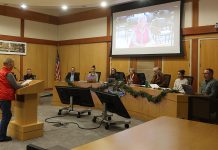Lengthy report outlines countywide COVID-19 protocol for schools
On March 5, the Sonoma County Office of Education (SCOE) released its Infectious Disease/Pandemic Response Plan in preparation for a continued outbreak of the COVID-19 novel coronavirus.
The 58-page report details the communication strategies and response protocols for the outbreak. It was largely borrowed from a plan created in Contra Costa County and then modified for Sonoma County’s needs, according to the introduction.
What is the communication hierarchy?
The plan describes how school district response is coordinated and organized in order to obtain “accurate and timely” information from the Sonoma County Public Health Department (SCPHD). SCOE must provide accurate and timely information to parents, students, teachers and staff and provide feedback to the county health department about how information is being received, interpreted and used.
They will also, if necessary, take required actions to close and re-open schools, when these actions are required; ensure continuity of school operations during a school closure; and ensure continuity of instruction during a school dismissal.
The county’s public health department is the lead agency, and their office will determine if a school closure is necessary, according to the plan. They will also be the primary source of information being distributed to school districts and down to families.
A significant amount of the report details the points of contact at various positions along the hierarchy, from the state all the way down to parents and families.
Each district will form at School District Communication Team to manage the task of providing information to the school community. Their tasks include monitoring updates, assisting in the preparation of and distribution information, printing handouts, setting up a generic email account that numerous people can access and sending the address to SCPHD so information can be sent to the school district. Informational materials will include only approved, updated and incident/disease-specific content prepared by SCPHD.
Districts are being encouraged to share this information in many ways, including mailing information to parents and staff; handouts at school sites; postings to school and school district websites, emails, blog sites, social media channels like Twitter and Facebook, as well as texting, and when appropriate, meetings and conferences.
How and when would they close schools?
Protocol for school dismissal is tightly defined in the plan. Only the Sonoma County Public Health Department can issue an order to dismiss a school, several schools or all schools in the county during a public health emergency. School district nurses or school principals cannot dismiss the school based on the on-site assessment of absenteeism or for any other reason.
The school district nurse monitors and reports illness and absenteeism to the Sonoma County Pubic Health Department nurse, and the decision to dismiss a school is communicated from the county health officer to the county school superintendent. The county superintendent communicates the order to the school district superintendent, who then contacts the school principal and school district nurse.
What about staff?
Staff absences and their impacts are also a large part of the plan. Teacher/staff absences will first be reported to the school district office. There will be a designated individual at each school for that reporting. That person is also responsible for recruiting substitute teachers and providing infection control equipment to substitute teachers, staff and volunteers. An individual in each district or school will contact absent teachers and staff and provide appropriate risk communication material, if required.
Of concern to most employees is the impact on their employment and pay. The plan suggests that work-related policies for teachers and staff include a review of the California statewide Disaster Service Worker policy. Employees may also refer to county-wide, district-level or school policies and procedures related to sick leave, care for family members.
According to the plan, SCOE will distribute information about state-level waivers during emergency response and the district superintendent will distribute work policies and information applicable within the district. The school principals/administrators will then work with their human resource and payroll departments to distribute work-related policies and information to teachers and staff.
What might happen during a closure?
Should the worst come to pass and significant numbers of schools are forced to close because of the outbreak, the report outlines plans to continue education practices. Each school district or school is responsible for maintaining the continuity of school functions during a prolonged school closure or during periods of increased absence of administrative staff and teachers.
The report identified several levels instructional continuity, ranging from the least effective to the most effective:
Exposure to content: Students will be able to view content that broadly relates to subject areas, such as literacy and numeracy, but no focused skill development is expected. Materials used might include, depending on the grade level, books, textbooks, workbooks, worksheets, e-mail, television (e.g., VHS, DVD, cable and satellite) and Internet content (e.g., websites and games).
Supplemental content: Students will be able to view and participate in activities that are directly related to grade-level skills, but there is no capacity for assessment or evaluation of work. Limited progress is expected. In addition to the materials listed above, more specific subject matter could be provided through content download (e.g.,using mp3 players, iPods, and cell phones) and communication by phone (e.g., conference calls, one-on-one calls).
Partial continuation: Students will be able to access grade-level and subject matter content. Continued learning is possible, if instructional support, including assessment and evaluation of work, is provided through another medium. Measurable student progress is possible. Materials and instructional methods used might include all those listed in the previous paragraphs as well as synchronous online learning (e.g., chat, streaming video, instant messaging, web conferences).
Full continuation: Students will be able to access grade-level and subject matter content. Instructional support is provided, including assessment and evaluation of work. Measurable student progress is expected. Materials and instructional methods used might include all those listed above as well as timed online learning with the capability for remote communication and assessment (e.g., email, learning management systems).
Student support services: Schools have a responsibility to ensure equal educational opportunities for all students and are required to provide special education to students with disabilities during school dismissals if any educational services are provided to the general student population. This includes ensuring that, to the greatest extent possible, each student with a disability receives the special education identified in the student’s individualized education program (IEP).
Students with special needs that may impact the effectiveness of this continuity of instruction include: low income students who depend on school meals, special education students and medically fragile/chronically ill students not already included as special education students.
How will schools reopen?
There are also guidelines about the process for reopening the schools. There is guidance regarding assessment of student levels with respect to state academic standards; guidance for screening and referring students to mental health services and guidance for assessing students with special needs in reviewing, revising or creating Individual Education Plans (IEPs).
If the school is used for emergency operations, there is also a process for supporting remediation after the emergency has passed.
What about finances?
Local school districts are concerned about the financial impact of any potential closures, especially coming on the heels of similar impacts from wildfires in recent years. The plan says that SCOE may provide guidance on state and federal requirements for continuity of school operations including policies and procedures regarding pay and benefits for employees and school funding during school dismissals.
SCOE will also assist with federal and state waivers that impact education during prolonged school dismissal, such as: requirements for the number of instruction days, amount of instruction time and length of the school day; graduation and promotion requirements; special education requirements; standardized testing requirements and deadlines and laws regarding the suspension of contracts.
The California Department of Education, Pandemic Influenza Manual 2009, provides guidance on notification and reporting procedures for student dismissals ordered by local or state health officials; fiscal impacts of student dismissals ordered by local or state health officials; accountability and assessment policies during extended student dismissals ordered by local or state health officials; continuity of education and student services during extended student dismissals ordered by local or state health officials; impact of pandemic on school facilities, child care, special education, the Healthy Start program, after school programs, curriculum support programs, professional development programs; and distance learning options during extended student dismissals.
The final portion of the plan consists of voluminous pandemic response checklists for school districts nurses, school district administration, SCOE, the SCPHD.









